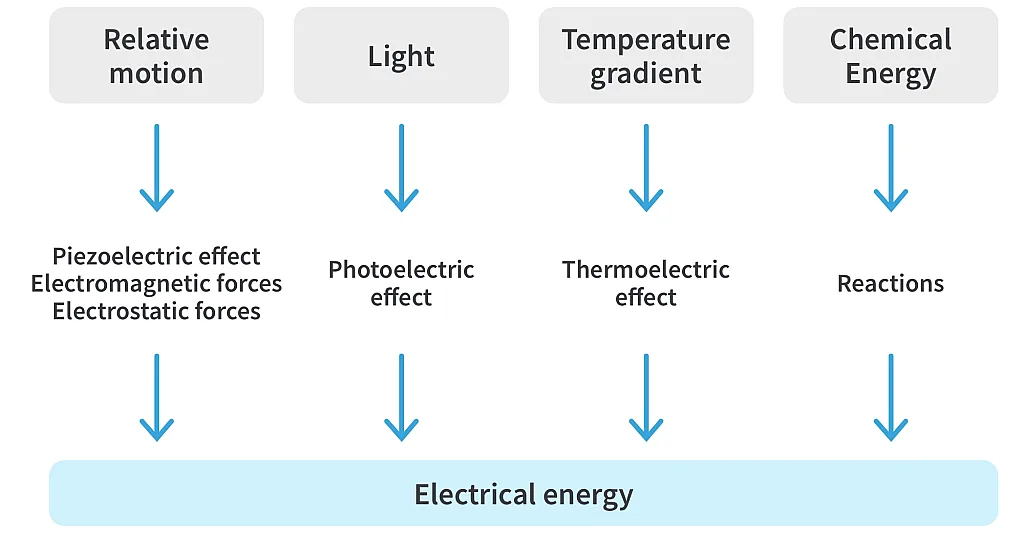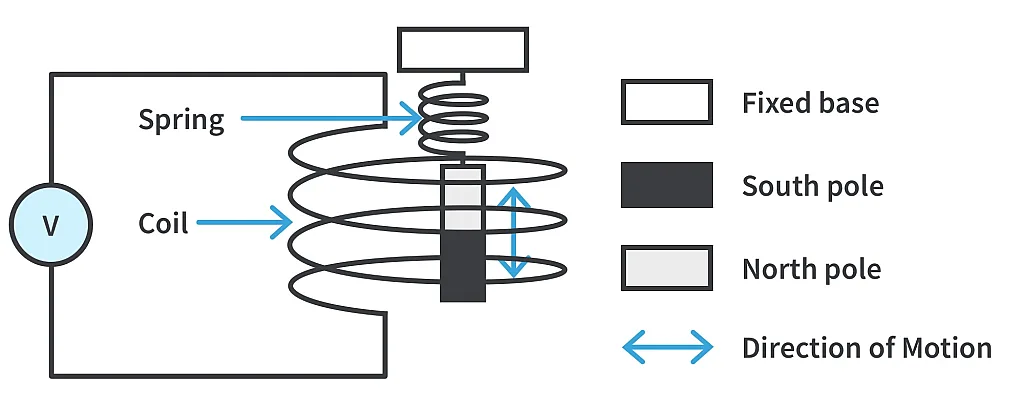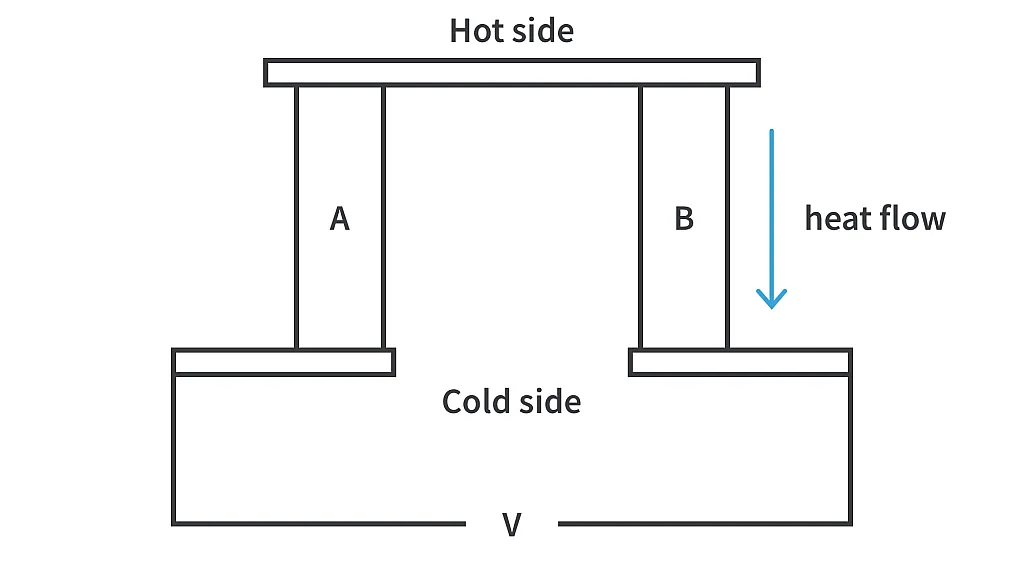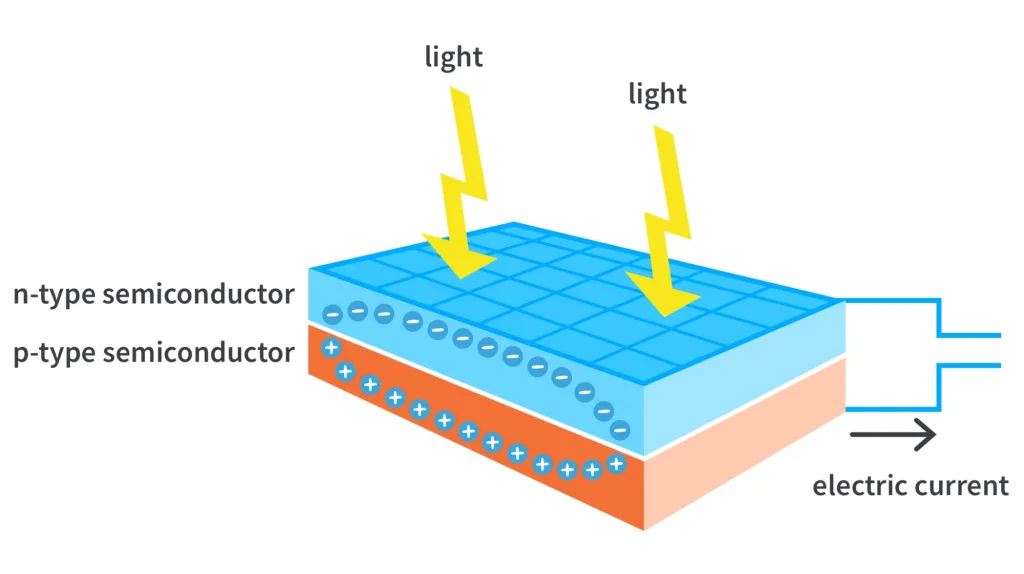Energy harvesting is the collection and harnessing of ambient energy in the environment. It involves the conversion of different forms of green energy into electrical energy useful in powering electronic devices or circuits. Consequently, energy harvesting, to a certain extent, can provide an alternative to small batteries. Compared to large-scale renewable energy generation (solar panels, wind generators), the amount of energy produced is much smaller, being typically tens of microwatts to a few watts. Most energy harvesters utilize small, low-power systems (in the range from nanowatts to hundreds of milliwatts) and in turn support just tiny amounts of power.
Energy sources for energy harvesting include motion/mechanical, light, temperature gradients, and chemical energy. Energy harvesters use conversion mechanisms to make use of the energy from the sources, as summarized below.

Motion
In piezoelectric energy harvesting, the piezoelectric effect transforms motion energy into electrical energy. Piezoelectric effect occurs on certain materials with the ability to generate an electric charge when mechanical stress is applied. In a piezoelectric material, mechanical stress affects electrical polarization, resulting in charge separation and thereby, in a voltage on the output.
In electrostatic harvesting, the electrostatic force between charged bodies is used to transduce mechanical energy into electrical energy. Consider a pair of charged parallel plates: the system has a capacitance C and with an initial charge Q. There is an electrostatic force Fes due to the opposite charges on the two plates. If one plate is moved so that the distance d between the plates is increased, Fes will produce work against the motion. This work is then transformed into electrical energy stored in the capacitor. In a system with some initial charge, if the motion results in a change of capacitance, there will be conversion between mechanical and electrical energy.

In electromagnetic energy harvesting from motion, the mechanism of induction as described by Faraday's law is utilized. Relative motion between a magnet and a coil varies the magnetic flux which inducts an electromotive force across the coils. The motion is damped and the corresponding energy is transformed into electrical. At large scales, this mechanism is typically implemented for rotational motion. In energy harvesting, the motion comes more often from other irregular forms such as vibrations in the surroundings or the motion of the human body.

Temperature Gradient
The Seebeck effect is used to transform heat flow to electricity. Consider a thermocouple with two materials, A and B, configured such that one of their sides is kept at a lower temperature and the other at a higher temperature. A and B are connected electrically at the hot side and the voltage across them is monitored at the cold side.

The temperature difference allows free-moving particles (electrons and holes) to carry heat flow. The motion of charged particles will cause space charges at the contacts of both A and B, which will create an electric field opposing the motion, until equilibrium is reached. For two completely identical materials A and B, the voltages will cancel out, but for different materials a non-zero total voltage V will appear that will cause a current flow through a load (if connected). In our immediate surroundings, anything warm to the touch such as electronic devices or a cup of hot water can provide harvesting potential.
Light

Converting light energy to electrical energy is not anything new. In 1839, it was discovered that metal would produce sparks of electricity when exposed to sunlight. This process was later named the Photoelectric effect on which photovoltaic technology is based. At the atomic level, light harvesters use the photoelectric effect to initiate electron motion. Photovoltaic (PV) cells have a thin semiconductor wafer, forming an electric field. When light hits the PV cell, electrons are knocked loose from the semiconductor atoms. With a closed electrical circuit where conductors are connected to both positive and negative sides, the electron motion can be captured as electric current used to power simple devices in the scope of energy harvesting.
Chemical Energy
Chemical harvesters employ various chemical reactions on the electrodes. The three basic components of these reactions are the positive electrode, negative electrode, and the electrolyte. Chemical reactions occur at the electrodes when the terminals are connected and electrons flow between them. Excess electrons released from the reactions will then flow from the anode to the cathode.
An example of chemical energy harvesting is the bio-battery. A bio-battery, just like typical batteries, has the three basic components and a separator which keeps the electrodes separated to avoid short circuits. Organic compounds such as glucose from human blood are used to power bio-batteries. Enzymes are used to break down glucose and the process releases several electrons and protons. This energy is then stored. The reactions involved are similar to how plants and animals obtain and store energy.
A naturally occurring process that harvests chemical energy is exploiting the salinity gradient of salt solutions. Salinity gradient energy harvesting makes use of the osmotic pressure difference between freshwater and saltwater. The pressure difference is the chemical potential that will prompt the more concentrated (higher pressure) salt solution to dilute the less concentrated solution by water diffusion through a semipermeable membrane. This pressure can drive turbines in power generators or directly pump out water in certain applications.
Applications and Implementation
Wireless devices are the main category of applications at the power levels of energy harvesting. For example, human motion is generally not enough to power mobile phones but is feasible for certain types of wireless sensors. Harvester size and the availability of ambient energy will set limitations to the implementation.
Given the usually small and intermittent output, a system design might include a boost converter, a charge controller for a rechargeable battery, a regulator, extra sensors, and a wireless connectivity module. When an energy harvesting device can supply the specifications of an autonomous system, the system can become battery-free.
Summary
Energy harvesting allows energy sources readily available in the environment: motion, temperature gradients, light and chemical energy to support simple devices for local, small-scale use. Piezoelectric, electrostatic and electromagnetic transduction are the mechanisms to harness motion energy. Thermal harvesters use the Seebeck effect (or thermoelectric effect) while light harvesters use the photoelectric effect. Chemical reactions and other naturally occurring processes are employed by chemical harvesters. Through research, more novel ideas in energy harvesting are still being proposed.









